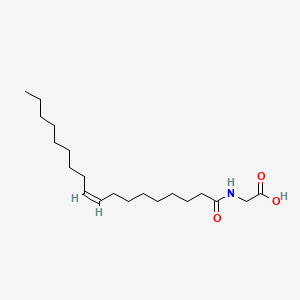
|
N-oleoyl glycine |
N-oleoyl glycine is a lipid of Fatty Acyls (FA) class. |
9 |
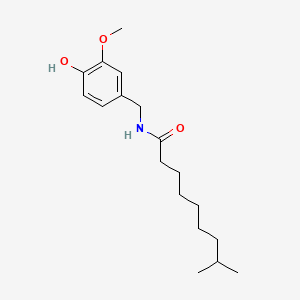
|
Capsaicin |
Capsaicin is a lipid of Fatty Acyls (FA) class. Capsaicin is associated with abnormalities such as Morphologically altered structure. The involved functions are known as inhibitors, Regulation, metaplastic cell transformation, Biochemical Pathway and Uptake. Capsaicin often locates in Tissue fiber, Mucous Membrane, Nerve Endings, group Ia axon and Membrane. The associated genes with Capsaicin are TRPV1 gene, WT-1, MAP1LC3A gene, EIF2S3 gene and SLC33A1 gene. The related experimental models are Transgenic Model. |
235 |
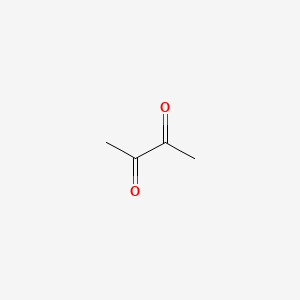
|
2,3-butanedione |
2,3-butanedione is a lipid of Fatty Acyls (FA) class. The involved functions are known as Physiologic Organization, Biochemical Pathway, physiological aspects, establishment and maintenance of localization and Phosphorylation. 2,3-butanedione often locates in Membrane, Microfilaments, Microtubules, Cell body of neuron and filamentous actin location. The associated genes with 2,3-butanedione are SLC33A1 gene and WASF1 gene. |
2715 |
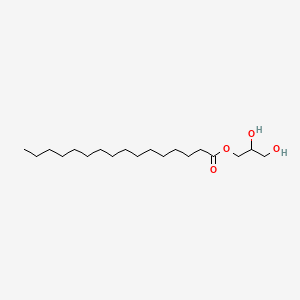
|
1-Palmitoyl-rac-glycerol |
1-Palmitoyl-rac-glycerol is a lipid of Glycerolipids (GL) class. 1-palmitoyl-rac-glycerol is associated with abnormalities such as Eczema, Food Allergy and Fatty Liver. The involved functions are known as inhibitors, lysophospholipase activity, Adjudication, cell transformation and Detergents. 1-palmitoyl-rac-glycerol often locates in Cytosol and soluble fraction. The associated genes with 1-Palmitoyl-rac-glycerol are FASTK Gene. The related lipids are 1,2-oleoylphosphatidylcholine, Lysophospholipids, phenyl valerate, Lysophosphatidylcholines and Palmitates. |
197 |
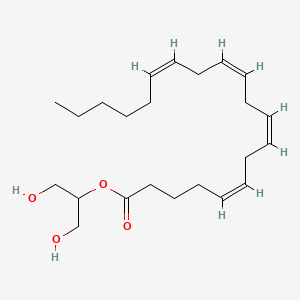
|
2-arachidonoylglycerol |
2-arachidonoylglycerol is a lipid of Glycerolipids (GL) class. 2-arachidonoylglycerol is associated with abnormalities such as Atherosclerosis, Heart Diseases, Inflammatory disorder, Colitis and Peripheral Neuropathy. The involved functions are known as Immunoreactivity, inhibitors, Stimulus, Esthesia and Signal Transduction. 2-arachidonoylglycerol often locates in Back, Presynaptic Terminals, Brain region, Blood and Body tissue. The associated genes with 2-arachidonoylglycerol are ADRBK1 gene, Homologous Gene, MGLL gene, PLA2G4A gene and peptide V. The related lipids are oleoylethanolamide, Lipopolysaccharides, Promega, stearic acid and 1-stearoyl-2-arachidonoylglycerol. The related experimental models are Knock-out. |
1892 |
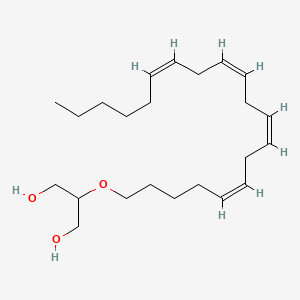
|
noladin ether |
Noladin ether is a lipid of Glycerolipids (GL) class. The involved functions are known as 5-(carboxyamino)imidazole ribonucleotide mutase activity and Competitive inhibition. Noladin ether often locates in Synaptosomes and Tissue membrane. The associated genes with Noladin Ether are IMPACT gene. The related lipids are noladin ether and Fatty Alcohols. |
72 |

|
tacrolimus |
Tacrolimus is a lipid of Polyketides (PK) class. Tacrolimus is associated with abnormalities such as Renal glomerular disease. The involved functions are known as inhibitors, Fungicidal activity, Metabolic Inhibition, Excretory function and Dephosphorylation. Tacrolimus often locates in Hepatic, Mitochondrial matrix and Inner mitochondrial membrane. The associated genes with Tacrolimus are RHOA gene and BGN gene. |
12730 |

|
erythromycin |
erythromycin is a lipid of Polyketides (PK) class. Erythromycin is associated with abnormalities such as Systemic Inflammatory Response Syndrome, Pneumonia, Infection, Pneumococcal Infections and Exanthema. The involved functions are known as Pharmacodynamics, Sterility, Agent, Drug Kinetics and Adjudication. Erythromycin often locates in Blood, peritoneal, Extracellular, Ribosomes and apicoplast. The associated genes with erythromycin are P4HTM gene, SLC33A1 gene, FAM3B gene, Operon and Homologous Gene. The related lipids are Hydroxytestosterones, Steroids, Propionate, Mycolic Acids and campesterol. The related experimental models are Mouse Model and Knock-out. |
19871 |

|
forskolin |
Forskolin is a lipid of Prenol Lipids (PR) class. Forskolin is associated with abnormalities such as Cholestasis, Vocal cord dysfunction familial, Hypothyroidism, Renal tubular disorder and Disintegration (morphologic abnormality). The involved functions are known as Cell Proliferation, Anabolism, mRNA Expression, Agent and Signal. Forskolin often locates in Extracellular, Body tissue, Skin, Tissue membrane and Membrane. The associated genes with forskolin are P4HTM gene, SLC33A1 gene, NR1I2 gene, Genes, Reporter and CYP3A gene. The related lipids are Steroids, steroid sulfate, Fatty Acids, LYSO-PC and Lipopolysaccharides. |
24755 |








